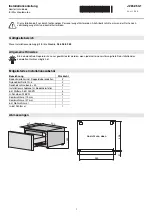
6
U S E R G U I D E
|
U V C S S I D E CU R E C O N V E Y O R
Checking the Workstation
The human eye cannot detect "pure" UV light, only visible light. A radiometer should be used to measure stray UV light to
confirm the safety of a UV light-curing process. A workstation that exposes an operator to more than 1 mW/cm
2
of UVA
continuously should be redesigned.
Protecting Operators
Light-curing technology can be a regulatory compliant, "worker-friendly" manufacturing process when the proper safety
equipment and operator training is utilized. There are two ways to protect operators from UV exposure: shield the operator
and/or shield the source.
Shield the Operator
UV-Blocking Eye Protection
- UV-blocking eye protection is recommended when operating UV light-curing systems. Both
clear and tinted UV-blocking eye protection is available from Dymax.
UV-Blocking Skin Protection
—
Where the potential exists for UV exposure upon skin, opaque, UV-blocking clothing, gloves,
and full-face shields are recommended.
Shield the Source of UV
Any substrate that blocks UV light can be used as a shield to protect workers from stray UV light. The following materials can
be used to create simple shielding structures or blind corners:
Sheet Metal
—
Sheet metal (aluminum, steel, stainless steel, etc) should be coated black or black anodized to minimize
reflection of UV and visible light toward operators.
Rigid Plastic Film
—
Transparent or translucent/UV-blocking plastics (typically polycarbonate or acrylic) are commonly used
to create shielding where some level of transparency is also desired. These rigid plastic films are available either clear or
tinted.
Flexible Film
—
UV-blocking, flexible urethane films can be used to quickly create workstation shielding. This UV-blocking,
flexible urethane film is available from Dymax, call for assistance.
High-Temperature Surfaces
Surfaces exposed to high-intensity curing lights may rise in temperature. The intensity, distance, exposure time, cooling fans,
and composition of the surface can all affect the rise in surface temperature. In some cases, exposed surfaces can reach
temperatures capable of producing a burn or causing damage to a substrate. In these cases, care must be taken to ensure
either a more moderate surface temperature or appropriate protection/training for operators.
Ozone
Standard Dymax lamps (UVA type) generate an insignificant amount of UVC and therefore essentially no ozone. Some UV
light-
curing systems, like those used to cure UV inks, emit primarily “shortwave” (UVB and UVC) energy. Upon exposure to
UVC light (specifically <240 nm), oxygen molecules (O
2
) split into oxygen atoms (O) and recombine with O
2
to create ozone
O
3
. The current, long-term ozone concentration limit recommended by ACGIH, NIOSH, and OSHA is 0.1 ppm (0.2 mg/m
3
).






































